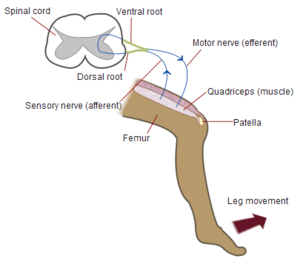Westphal's sign
Westphal's sign is the clinical correlate of the absence or decrease of patellar reflex or knee jerk. Patellar reflex or knee jerk is a kind of deep or stretch reflex where an application of a stimulus to the patellar tendon such as strike by a solid object or hammer caused the leg to extend due to such stimulus causes the quadriceps femoris muscle to contract.
| Westphal's sign | |
|---|---|
 | |
| Patellar tendon reflex arc | |
| Differential diagnosis | Peripheral nerve disease, Motor cortex lesion |
It is named for Carl Friedrich Otto Westphal (1833-1890).[1][2]
Associated conditions
Westphal's sign has a clinical significance used in determining neurodisorders or diseases such as:
- receptor damage, peripheral nerve disease, involving the dorsal(sensory) columns of the spinal cord and cerebellar lesions
- lesions present within the motor cortex of the brain or the pyramidal tracts which it combined with muscular spasms
- complete interruption of sensory and/or motor impulse transmission in the femoral nerve
References
- synd/945 at Who Named It?
- C. F. O. Westphal. Über einige durch mechanische Einwirkung auf Sehnen und Muskeln hervorgebrachte Bewegungs-Erscheinungen. Archiv für Psychiatrie und Nervenkrankheiten, Berlin, 1875, 5: 803-834.
- The Principles of Physiology Jensen, David Ph.D., Appleton-Century-Crofts, New York.1976
This article is issued from
Wikipedia.
The text is licensed under Creative
Commons - Attribution - Sharealike.
Additional terms may apply for the media files.